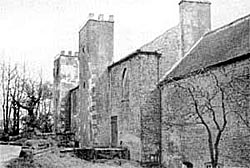< Previous | Contents | Next >
Castle Mill, Linby
 |
THE course of the River Leen from its source at Hollinwell to its confluence with the Trent is about ten miles in length, as the crow flies. Indeed, its name, which derives from the Anglo-Saxon word " Hlynna," means a " streamlet," so that it is hardly worthy to be called a river.
And yet it was of great importance during the middle ages, for it formed a part of the western boundary of the forest of Sherwood, and its waters fed the fish stews and supplied the domestic needs of the two great monasteries of Newstead and Lenton and of the Royal Castle of Nottingham.
Moreover, although the fall of the Leen Valley is gentle, the flow of the river was sufficient to turn a number of water-wheels, and at one time a score or so mills were erected on its banks, traces of some of which may even yet be found.
In the Domesday Book we read that there was a mill at Linby in Norman times, and this mill is again mentioned in a perambulation of the Forest boundary in 1232, but the Castle Mill is a new builtling erected in the eighteenth century in pseudo-Gothic style.
During the last quarter of the eighteenth century the cotton industry flourished in the neighbourhood of Nottingham, and in 1785 James Watt set up in the Castle Mill, Linby, the first engine built by him for a cotton mill. Labour was found for these mills on the Leen (and for many others throughout the country) by a system of indenture which was little better than slavery. Children who were left stranded in the workhouses or who otherwise became chargeable to the parish were apprenticed to these factories.
The supply of child labour provided by London and other great centres of population was very great, and the treatment meted out to them was abominable.
The registers of Linby contain frequent references to the death of " a London boy," and the fact that 163 children lie buried in Linby churchyard alone is a sufficient comment on the horrors of a system which came to an end in 1834.
Castle Mill lies below a great artificial lake, designed to form a head of water for the mills. One of Lord Byron’s mad pranks was to hold the water up until a considerable head had accumulated, and then to let it go suddenly. He succeeded in flooding the lower valley and doing a great deal of damage, but it seems unlikely that his action won him popularity amongst his neighbours.
